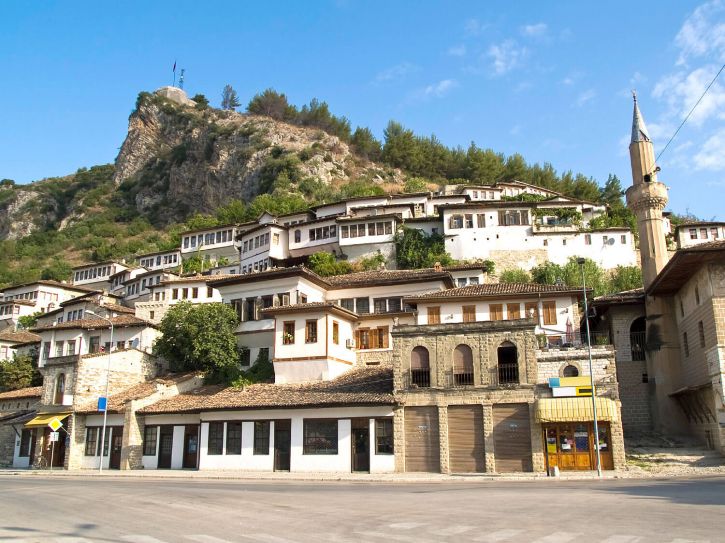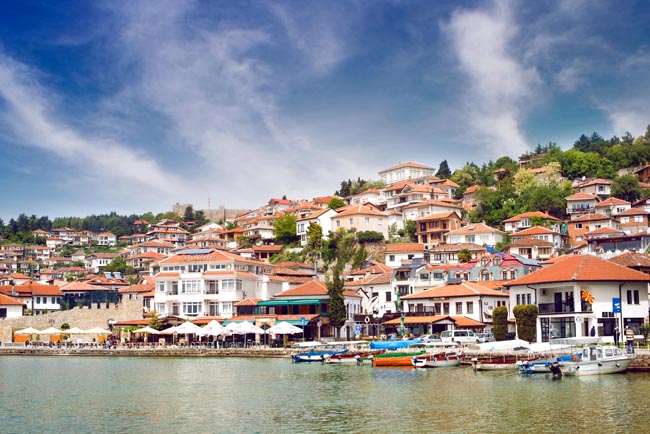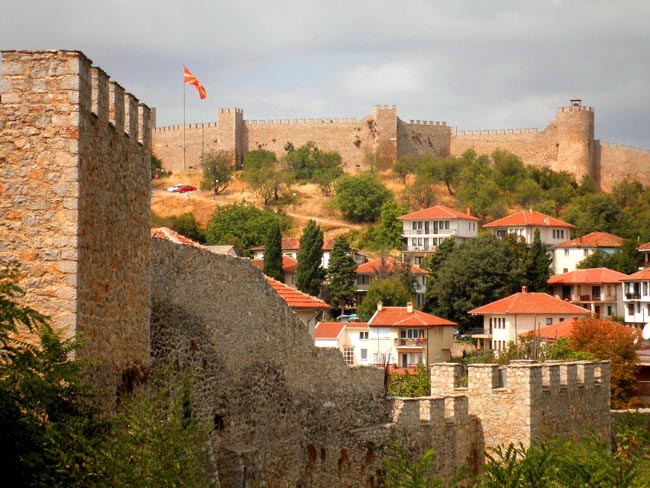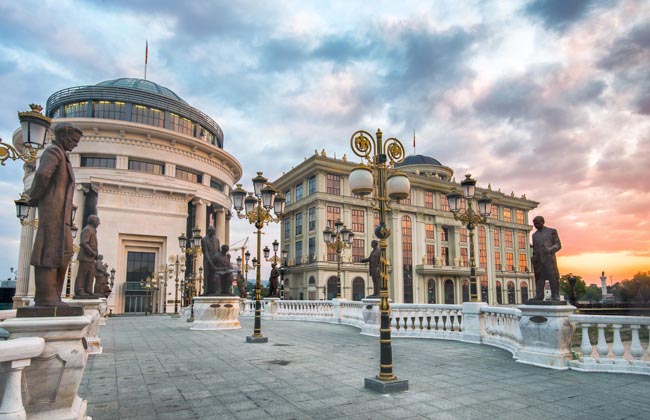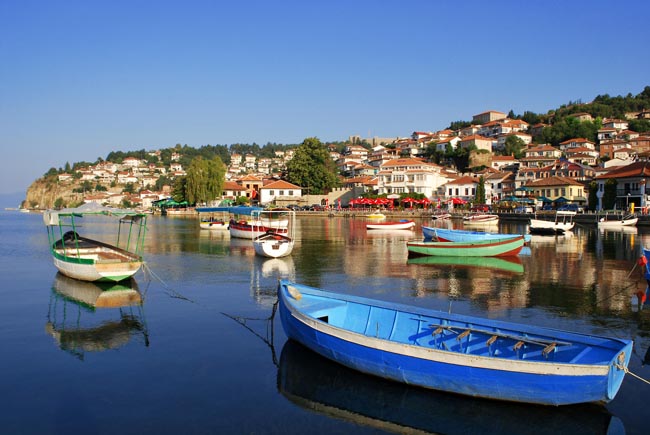Embark on a comprehensive 2-week tour of Albania and Macedonia, exploring two UNESCO World Heritage sites: Butrint and Berat. Uncover ancient ruins, witness dramatic history, and experience the vibrant culture of these lesser-known Balkan gems.
Start in Tirana, Albania's capital, and visit the historic fortress of Kruja. Explore the Ethnographic Museum and Scanderbeg Museum, then delve into the chilling past at Bunk'Art 2, a repurposed nuclear bunker.
Continue to Berat, a UNESCO-listed city with well-preserved Ottoman architecture. Visit the Onufri Museum, explore the Citadel, and wander through the Lower Town.
Hike to Ardenica Monastery and visit Apollonia, an ancient Greek city. Explore Butrint, a UNESCO site with rich history, and drive to Gjirokastra, another UNESCO-listed city with unique stone houses. Visit Skenduli House and the citadel, then head to Korca, known for its carnival and culture.
Cross into North Macedonia and visit Ohrid, a UNESCO World Heritage site with a historic town center, beautiful lake, and ancient churches. Explore Prespa Lake, Heraclea Lyncestis, and Tetovo, home to the Painted Mosque and Arabati Baba Teqe.
Conclude your tour in Skopje, Macedonia's capital. Visit the Museum of the Old Skopje Bazaar, walk through the old town, and explore the Kale Fortress and Musapha Pasha Mosque.
Prices below are per person, twin-sharing costs in US Dollars (USD). Pricing does not include airfare to/from the tour and any applicable taxes. For single supplement rates and taxes (if any), please refer to below Prices & Dates table. For general information on flights to/from the tour, click here.
Your Travel and Accommodation Arranged For You
Tips Included for Driver, Restaurant Staff, Local Guides
Authentic Local Experiences With Lots Of Inclusions.
Select a date below to reserve your spot:
Optional Single Supplement: $760 USD (number of singles limited).
Download Itinerary
Day 1 Arrival in Tirana
Today we arrive in Tirana, capital of Albania. Tirana is located on a plain on the site of a Byzantine fortress and has been the capital since 1920.
Once infamous for its isolation, Albania is one of the smallest as well as the poorest countries of Europe. Today this is a country that is slowly making the transition to open-market economy and moving on the road to progress. In the heart of the Mediterranean, on the Adriatic and Ionian Seas, Albania is soon to become one of Europe's most interesting getaways. Still relatively unspoiled by globalization, you will notice an inspiring mixture of civilizations and cultures, making this country truly unique.
Overnight in Tirana.
Included Meal(s): Dinner
Day 2 Tirana & Kruja
This morning we travel to Kruja, a small town perched high on the face of a hill and the centre of the Albanian resistance against the Ottoman Turks under the leadership of national hero, Scanderbeg. We visit the fortress of Kruja, the Scanderbeg Museum, Ethnographic Museum, and the old bazaar full of souvenirs, including hand-made articles.
Afterwards we return to Tirana where we have a tour of the capital, including Ethem Bey Mosque (possibly closed for (closed for restoration – if so, we will replaced with the World Bektashi Headquarters in the outskirts of Tirana), and Bunk'Art 2, a 1000-square-meter bunker with reinforced concrete walls up to 2.4 meters thick, built between 1981 and 1986 to shelter elite police and interior ministry staff in the event of a nuclear attack. Now a museum, it now holds photographs and equipment that illustrate the political persecution of some 100,000 Albanians from 1945 until 1991. The “Pillar” museum, as the nuclear bunker was codenamed, is one of several former hideouts the Albanian government has repurposed for the public.
Overnight in Tirana.
Included Meal(s): Breakfast and Dinner
Not finding what you're looking for?
Our specialists can take away the stress and create a private custom tour tailored to your exact interests and budget.
Day 3 Tirana - Durres - Berat
Today we will drive to Berat via Durres (formerly Durrazzo), Albania's second largest city and one of its oldest towns. Legend has it that Durrazzo was founded by the Illyrian King, Epidamnos, who called it by his own name and named the port after his grandson, Dyrrah. It was for centuries the largest port on the Adriatic and got back into world highlights when in 1939, the Italian troops met brief but fierce resistance, and those killed defending it are now regarded as the first martyrs of the War of National Liberation.
Our visit to Durres will include the archaeological museum and the Roman amphitheatre. The amphitheatre is one of the largest in the Balkans and located in the city close to the harbour. This 1st century construction is currently under consideration for inscription as a UNESCO World Heritage site. We will also walk from the amphitheatre over to the ruins of the Roman Baths located behind the Aleksander Moisiu Theatre on the central square.
Our final destination for today is Berat, known as a "city of one thousand windows", and declared a "museum city" and UNESCO protected site. A highlight of any trip to Albania, Berat is one of the country's most beautiful towns. The old name of the city was Antipatrea, built on the slopes of mountain Tomorri, with a castle dominating over the city. Within the city walls there are houses and the Onufri Museum, where we see paintings by this outstanding painter from the 16th century, as well as paintings from his son Nikolla.
We will spend most of our time touring in the old part of the town. This is perhaps one of the best-preserved Ottoman cities in the Balkans, with a lively lower town and a beautiful medieval citadel district on top of the hill. One of Berat's highlights is a visit to the inhabited citadel. Once inside the walls, we can visit ruined mosques and several medieval Orthodox churches, all intact and with restored frescoes and icons. The famous Onufri museum is housed in a wonderful church and holds the best collection of Albanian icons. In the lower town we will see the Leaded Mosque, so named for the roofing material, the Bachelor's Mosque (possibly closed for renovations), the Sultan's Mosque, and the Ottoman han (inn).
Overnight in Berat.
Included Meal(s): Breakfast and Dinner
Day 4 Berat - Ardenica Monastery - Apollonia - Saranda
Today we travel to the rarely-visited yet magnificent Ardenica Monastery, remotely located on a hilltop between the towns of Lushjë and Fier. In the fantastic interiors of the 18th century Church of St Mary, the iconostasis dominates the nave, but equally impressive is the golden pulpit, which positively heaves with adornments, not to mention the frescoes of the Zografi brothers that can be seen on display upstairs.
We continue to Apollonia, founded in 558 BC by settlers from Corfu and Corinth. After a tour of the Roman site's library and beautiful Odeon, we proceed to the town of Saranda, the southernmost town on the Albanian coast. It became important in Roman times as a strategic point along the sea route between Italy and Greece.
Overnight in Saranda.
Included Meal(s): Breakfast and Dinner
Day 5 Saranda & Butrint
Today we have a morning visit to the Greek and Roman ruins of Butrint, Albania's most important archaeological site.
Butrint dates from the 7th century BC, later becoming a Roman colony, then falling under the sway of the Venetians and Turks. Virgil claimed that the Trojans settled Butrint, but no evidence of this has yet been found. Within a century of the Greeks arriving, Butrint had become a fortified trading city with its own acropolis, the ruins of which we can still visit. The rediscovered city is a microcosm of almost 3,000 years of Mediterranean history -- its 6th century BC fortification evokes the city's military power and symbolizes the rich culture of the once thriving ancient city.
Overnight in Saranda.
Included Meal(s): Breakfast and Dinner
Day 6 Saranda - Gjirokastra
Today we drive to Gjirokastra, the birthplace of iron-fisted former dictator of Albania, Enver Hoxha. Gjirokastra is a picturesque town, perched on the side of a mountain above the Drino River. On the way we pay a quick visit to the 'Blue Eye", a fresh water spring in the shape of an eye, amongst dense vegetation.
The museum city of Gjirokastra was built on the eastern side of “Mali i Gjerë”. Since 2005, it has been in UNESCO World Heritage site. The origin of the city starts with the castle, built in the fourth century AD. In 1417, it was conquered by the Ottoman army and reached its peak over 1800-1830 when monumental assembly houses were built. The first neighbourhoods are those of Bazaar and Hazmurate. The main characteristic of Gjirokastra is the intensive use of stone in building the houses, which look like small fortresses, and the streets of cobblestone, which all lead to the bazaar. Due to all these features, Gjirokastra is also known as the “The Stone City”.
We'll visit the Skenduli house, a magnificent example of the marriage of Albanian and Ottoman architecture. We also visit the pre-Ottoman citadel with a weapons museum and former political prison.
Overnight in Gjirokastra.
Included Meal(s): Breakfast and Dinner
Day 7 Gjirokastra - Kamenica - Korca
After breakfast we drive to Korca.
This will be a long driving day (actually only 200km) through the fabulous southeastern part of Albania. The delight of the day will be the beautiful panorama with mountains, rivers, forests and national parks, gorges and cataracts, and isolated little villages of this part of Albania. We will most probably do several stops in Leskovik and the nearby villages to see bunkers from the former communist military garrisons today transformed into animal shelters.
En route to Korca today we'll also stop at the Tumulus of Kamenica after a break in Rehova for lunch. The tumulus represents the largest burial monument of its kind in relation to 200 tumuli excavated in Albania and neighboring Balkan countries. The site includes a museum dedicated to the prehistory of Albania and of the surrounding region.
We continue to Korca (pronounced: 'Korchah') through Kelcyra and the spectacular Vjosa canyons stretching to Permet, the mountains of Leskovik, and the colourful fields of Erseka. Korca is a historic place with rich cultural traditions and some interesting buildings from the Ottoman period, including one of the most important mosques in Albania.
Overnight in Korca.
Included Meal(s): Breakfast and Dinner
Day 8 Korca: City Touring & Voskopoja
Korça is one of the largest and most important cultural and economic centers of Albania. The city is known for its typical quarters composed of low houses and villas, which are paved with cobblestone. Because of its beauty, French-style villas and coffee culture, Korca is often called the ‘little Paris of Albania’.
This morning we visit the Bazaar of Korca and National Museum of Medieval Art. This must-see museum houses 7,000 items of cultural significance and even a few pieces by Onufri, the most famous icon painter in the country. The old Bazaar has great early historical, cultural and artistic value for the city. It is characterized by one and two story buildings in classic Korça style, separated by narrow cobbled streets that open onto a central square. In past centuries, the bazaar has functioned as a market for trade not just within Albania, but also from Turkey, Greece, Trieste, and Venice. It has been noted for the row of inns, including the Old Elbasan and Old Monastery Inn, which served to host travellers visiting the market from outside the city. The market reached its apex during the late 19th and early 20th centuries with more than 1,000 stores; with so many shops, the bazaar was like a city within a city.
This afternoon we visit the nearby town of Voskopoja, which became one of the most developed and prosperous cities in the European part of the Ottoman Empire between the 17 and 18th centuries. Testament to this are the first Printing House in the Balkans in 1720, the Academia of Voskopoja founded in 1744, the famous Basilicas, the painted house walls by the famous Albanian painters including David Selenica and the Zeografi brothers.
Overnight in Korca.
Included Meal(s): Breakfast and Dinner
Day 9 Korca - Pogradec, Albania - Ohrid, North Macedonia
Today we travel to Lake Ohrid, the deepest in the Balkans. We stop at Tushemisht village for a visit of the villa of the former Albanian dictator, Enver Hoxha.
We cross into North Macedonia (known before 2018 as just 'Macedonia'), a landlocked and mostly mountainous country in southeastern Europe, North Macedonia proclaimed independence from Yugoslavia in September 1991. Its mountainous landscape is right at the heart of the Balkans, sprinkled with beautiful valleys and lakes, with a rich Hellenic heritage. Its churches and mosques contain many fine examples of art and architecture from the Byzantine and Ottoman periods.
Our final destination today is the city of Ohrid, an attractive little town on the Balkan Peninsula and is the pride of North Macedonia. With its historic town centre and stunning Lake vistas, this place really is a gem. For Orthodox Macedonians it is the spiritual heart of their country and a focus of national pride. It was here that Sts Clement and Naum in the 9th century founded the first Slavic university. Time-permitting, we may accomplish some of our Ohrid sightseeing today upon arrival.
Overnight in Ohrid.
Included Meal(s): Breakfast and Dinner
Day 10 Ohrid: Area Tour
Today we have a walking tour around the old 'town-museum' of Ohrid, a UNESCO World Heritage Site. The old part of the town was known in ancient times as Lychnidos, the City of Lights. Slavs gave it the name of Arida in the 10th century, and it became a major center of culture and art for this area. It is the cradle of Slavic written language and literature, from where the alphabet called Cyrillic was created by the two brothers Cyril and Methody.
Ohrid is also known as the "City of 365 Churches" and we visit a few of the most important ones. St. Panteleimon Monastery from the 9th century is the oldest Slav monastery in the world. Ohrid abounds with ancient archaeological sites, including an amphitheatre and fortress. During our tour of Ohrid we will also walk through the local bazaar. While in Ohrid we'll also visit the Roman Amphitheater.
This afternoon we embark on a boat tour on the lake. Our journey will take us along the eastern shores of the lake and down to the southern tip. We will disembark for a tour of the 10th century Monastery of Saint Naum before returning to the town of Ohrid on the northern shores.
Overnight in Ohrid.
Included Meal(s): Breakfast and Dinner
Day 11 Galcica National Park & Bitola
Today we we proceed to Prespa Lake for a drive through the National Park of Galcica, bordered on two sides by lakes Prespa and Ohrid. The views the park afforded of both lakes is impressive, punctuated with villages of whitewashed houses with red tiled roofs.
We'll stop at Heraclea Lyncestis, among Macedonia's best archaeological sites. We see the Roman baths, portico and amphitheatre, and the striking Early Christian basilica and episcopal palace ruins, with beautiful, well-preserved floor mosaics – they're unique in depicting endemic trees and animals.
Afterwards we proceed to Bitola for a walk along the old and well known Sirok Sokak (Broad Street), where the Consulates of European countries were located at the time of the Ottoman Empire.
After free time for lunch and refreshment, we continue to Gazi Haydar Kadi Mosque,* dating from 1561. This mosque, with perfect proportions and two minarets, is one of the most beautiful examples of classical Turkish style of architecture. We also include Yeni Mosque, built in 1558 and well-known for its exquisite decorative ornaments and stalactites. Finally, St. Dimitrija, built in 1830, is a cathedral well-known for its wood carved iconostasis and ecclesiastical furniture.
* Please note that both mosques have been periodically closed for renovation, which seems to occur on an unpredictable schedule. Should this be the case for our visit, we may visit Kemal Ataturk and the Bitola Museums instead.
Overnight in Ohrid.
Included Meal(s): Breakfast and Dinner
Day 12 Lake Ohrid - Tetovo - Skopje
Today's route will take us across the National Park of Mavrovo with its majestic lake, river, gorges, and waterfalls. En route we stop at the amazing monastery of Sveti Jovan Bigorski. In Tetovo we will stop to visit the Painted Mosque located by the Pena River, constructed in 1459 on the foundation of an older edifice. An example of early Constantinople style, this mosque is adorned with an elaborate painted facade and interior, making it unique in Macedonia. In the turbe next to the mosque is the body of the two women who provided money for the mosque to be built in 1459. We also include the Arabati Baba Teqe, a blending of mosque, church and shrine for Sufi Muslims.
We finish in Skopje, once located at the far north reaches of the Byzantine Empire. The name of the city itself reflects its geographic location and role within the empire, as the word Skopia translates to watch-tower / lookout / observation point.
Overnight in Skopje.
Included Meal(s): Breakfast and Dinner
Day 13 Skopje: City Tour
Skopje is not only the capital but also the largest city in North Macedonia.
Located in a valley on both sides of River Vardar, Skopje traces its ancient history back over 2,000 years to when it was known as Skupi. This region has been ruled at various times by ancient Rome, Byzantium, the First Bulgarion Empire and the Ottoman Turks. The Skopje Old Bazaar emerged and developed in an area between the Stone Bridge and the Bazaar, and between the Kale fortress and the Serava River. As early as in late middle age, all economic activity of the town took place here. In the period between the 16th and 17th century, the Old Bazaar reached its urban and economic zenith, developing into one of the largest and most significant oriental old bazaars in the Balkans.
Today the Old Bazaar abounds in cultural and historic monuments. During our walk we will be sure to visit the Museum of the Old Skopje Bazaar. Located on the 1st floor of a 15th century inn, this small museum is an essential stop for insight into Skopje’s historical importance. We'll also include the new new Archeology Museum, where more than 6,000 artifacts from all historical periods, from prehistory until the Middle Ages are presented.
A walk through the old part of the town allows us to explore this historical city. We will see the Stone Bridge -- a symbol of Skopje built by Turks in 15th century. This is a landmark of the city and an important link between the bazaar area and the modern part of town. The Kale Fortress, with walls dating back from the 6th century, is where a town was first started. This was the great town of Justinia Prima, founded by emperor Justinian, and later used as military barracks by the Ottomans from the 14th to 20th centuries.
Other notable Ottoman monuments we will see today include the Mustapha Pasha Mosque, a marvel of Ottoman architecture towering above the old bazaar area, and the Daut Pasha Hamam (bath), considered a masterpiece of 15th century Islamic civil architecture.
Overnight in Skopje.
Included Meal(s): Breakfast and Dinner
Day 14 Departure
Departure from Skopje.
BON VOYAGE!
Included Meal(s): Breakfast
Inclusions
Full-time Tour Leader and local guide support at some locations.
Breakfast and dinner (hotels & local restaurants) daily.
All transport, accommodation, sightseeing and entrance fees for sites noted as 'visited' in the detailed itinerary.
Gratuities for local guides, drivers, restaurant staff, porters.
Airport transfers for land & air customers and for early arriving/late departing land & air customers who book their extra hotel nights through us.
Exclusions
International airfare to/from the tour.
Tour Leader gratuities, lunches, drinks, personal items (phone, laundry, etc), international air taxes (if applicable), excursions referenced as 'optional'.
Airport transfers for Land Only customers.
Seasonality and Weather
Between April and June, weather in Albania is pleasant. The winter cold has faded away and the summer heat hasn't yet begun. The weather is pleasant in the coastal areas and in the mountains, especially in the western part of the country. This is a shoulder season, so there will be fewer crowds in the country compared to summer.
September and October are two of the best months to visit Albania. The summer heat starts wearing off and the fall colour can be stupendous. The weather is comfortable though evenings might be a little chilly. This is also a shoulder season, so you don’t have to worry about crowds.
Transport and Travel Conditions
Land transport throughout by private air-conditioned motor coach, 24-36 seats depending on ultimate group size (see 'group size'). We will have some full bus days on poor, winding roads, though the scenery is often spectacular.
This trip is typical of most of our European tours, which are ambitious and involve full days of travel and sightseeing. While we don't have any actual strenuous activity (ie hiking) built into the program, you will do a lot of walking on this trip. These walks will mostly be in the form of walking tours of towns and cities and short walks to dinner. Being Europe, and a hilly/mountainous area, cobbles, uneven surfaces, and slopes/stairs are common. If you are accustomed to typical "bus tours" which heavily rely on vehicular transport for all sightseeing activities, you should be aware that this tour is considerably more active.
Am I suitable for this tour? Please refer to our self-assessment form.
Activity Level: 2
These are particularly busy tours that feature a lot of moving around, sometimes by train and short journeys on local transport. Walking tours of towns and cities are leisurely but you should be prepared to be on your feet for several hours. Some of our cultural trips that occur at high altitude and/or require greater independence with baggage handling (at hotels, airports, train stations) also fall into this category.
To learn more about the Activity levels, please visit our tour styles page.
Accommodation
Simple yet clean hotels (3-star in major towns and cities); many are smaller properties (3-4 story) that may not have elevators. All hotels have en-suite toilet and bath, though most have shower only (no tub). Porter service is sometimes available; you MUST be independent with your luggage. Single rooms are limited in number and likely smaller than twins.
Staff and Support
Tour Leader, driver, local step-on guides in various locales.
Group Size
Maximum 18 plus Tour Leader
Tour Extensions
This tour is part of a series that can be upgraded to make for a longer trip. For more options, please refer to tour code/s:
Tour Overview Countries Visited: 5 Acivity Level: 2 Tour Style: Cultural
Our Adriatic, Albania & Macedonia Tour begins in Slovenia, past glacial lakes, lush green valleys and majestic mountain ranges, and venture through culturally fascinating small towns bustling cities and quaint hamlets brimming with historic sites of interest.
We enjoy a easy-paced walking tour of the capital, Ljubljana, a city that reminds one of Vienna and Prague, before heading into Croatia and exploring the Istrian Peninsula, a region rife with ancient Roman and Illyrian relics and monuments.
With the convergence of 16 lakes in a series of cascading waterfalls, the Plitvice Lakes is a destination of unique natural beauty and one that has been designated a UNESCO World Heritage Site and from here, we travel along the Dalmatian coast, taking in the centuries-old cathedrals, monasteries and fortresses that dot the Croatian countryside.
We venture into Bosnia and Herzegovina, where we bear witness to a blend of Mediterranean and Oriental architecturE.
After a memorable drive along the breathtaking Adriatic coast, we make for Tirana, Albania, and expose ourselves to the intriguing contemporary culture of this destination that lays claim to a fabulous collection of wondrous mosques as well as innumerable archaeological artifacts that detail almost 3,000 years of history.
We travel farther afield from the capital, stopping in at various towns and cities along the Albanian Riviera and beyond to appreciate Roman amphitheatres, ancient bridges, Franciscan churches and glorious panoramas.
Regions visited: Central And Eastern Europe
Countries visited: Albania and North Macedonia
*The red tour trail on the map does not represent the actual travel path.
The following is a list of sample hotels at some locations included on this tour. The hotels shown here are meant to provide a general sense of the standard of hotel we usually aim for; they are not necessarily confirmed for your chosen departure.












At Hotel Brilant, besides accommodation in comfortable rooms, you will be able to enjoy breakfast on the fifth floor as well as the fantastic sea view.




360 View The hotel is just a short, pleasant walk from the old town where one can discover the ancient monuments, exciting nightlife, breath taking lake view particularly at sunset, surrounded by natural and cultural beauties all around and nothing but the blue sky and sparkling waters of the Lake Ohrid for as far as the eye can see.





